The renowned modernity of its cities and infrastructure contrasts with the venerable charm and fairy-tale architecture of its country towns, or the dense remoteness of its hill forests. Germany’s landscapes run from glittering lakes and snow-capped Alpine peaks in the south to spectacular river gorges and even long sandy beaches, on the Baltic Coast.
Around Berlin
Germany offers all the qualities of a classic tourist destination – cosmopolitan cities, ever-changing landscapes and a wealth of cultural attractions. Its rich and turbulent history is ever-present. Visitors to Berlin 1 [map] should also take in Potsdam 2 [map] and Sanssouci (Tue–Sun), the grand palace that Frederick the Great designed in 1744. Here he patronised the arts and entertained his famous guests, such as the French philosopher Voltaire.

The castle at Heidelberg dominates the town.
iStockphoto
Today tourists flock to Sanssouci, which has 12 gloriously decorated Rococo rooms and a 290-hectare (717-acre) park. Beside the main alley the gold of the Chinese Tea House reflects the sunlight. At the end of the long path is the Neues Palais (New Palace), the residence of Frederick the Great’s household and guests towards the end of his reign. Within the park there is also a Sicilian Garden, with subtropical plants; the Renaissance-style Orangery; and the Picture Gallery, with paintings by Caravaggio, Rubens and Van Dyck. Cecilienhof Palace (Tue–Sun), venue for the 1945 Potsdam Conference, is nearby.
Through the Harz
The journey from Berlin through the modern state of Saxony-Anhalt to Leipzig is a series of contrasts. Until 1990 this area was part of East Germany, the GDR, and many of its small towns and villages still have a sleepier, more old-fashioned feel than those further west. In the Harz Mountains, the picture-book landscape is one of half-timbered houses and fine Romanesque buildings. Brandenburg 3 [map], straddling the River Havel, flourished in the 14th and 15th centuries as a centre for the cloth trade, but its importance declined with the rise of Berlin. Today, the town is dominated by the steel industry, but some gems remain, such as the cathedral, transformed into a Gothic basilica in the 14th century.
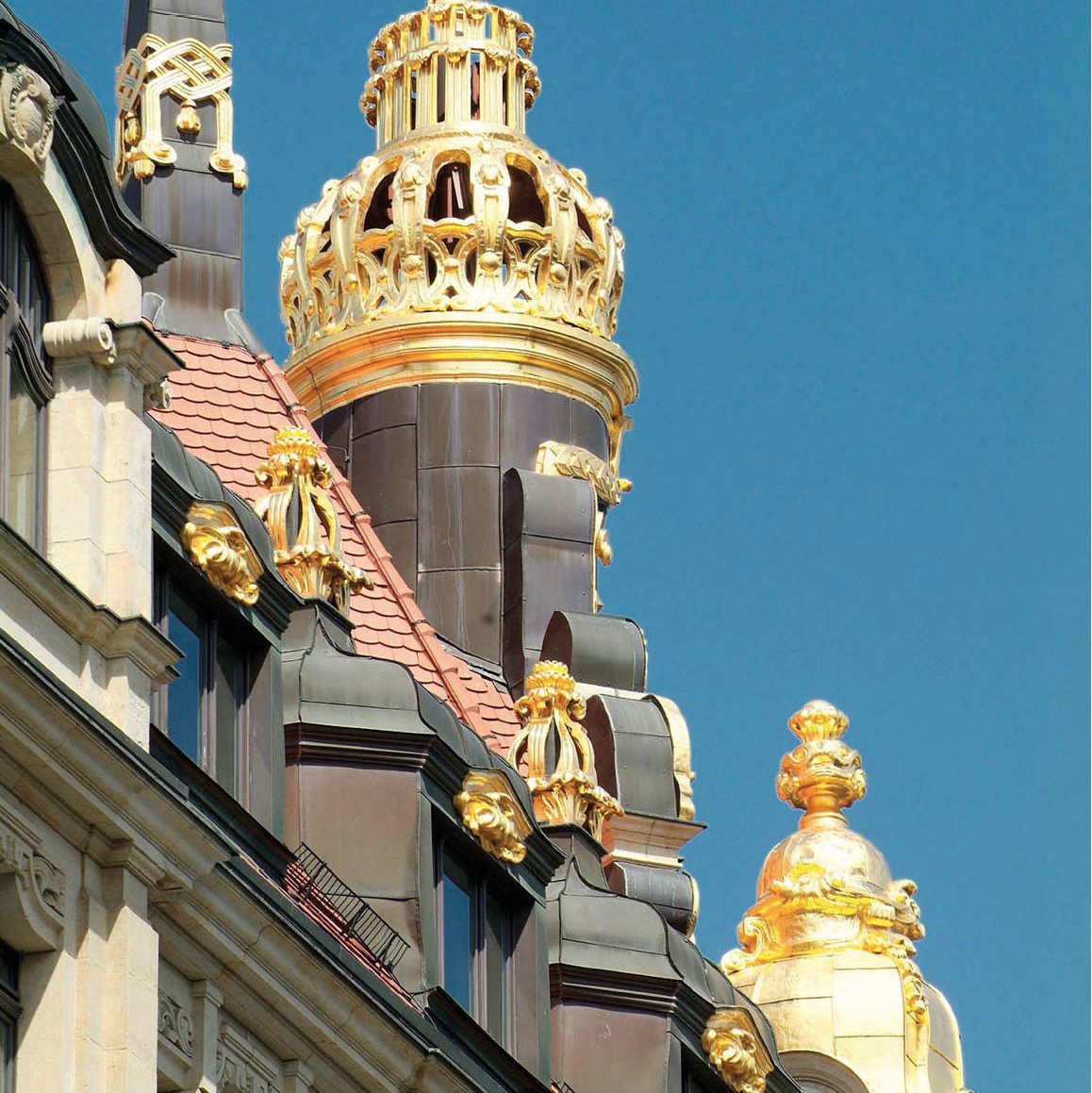
Magdeburg 4 [map], on the River Elbe, is the capital of Saxony-Anhalt and the biggest inland port in eastern Germany. The city suffered extensive damage during World War II, but many Romanesque buildings survive, including the Unser Lieben Frauen Kloster (Monastery of Our Lady; 1064–1160), which now serves, among other cultural roles, as a concert hall.
Approaching Lutherstadt Wittenberg 5 [map] from the west, the first impression is of the Schlosskirche, whose dome looks like a well-fitting crown. It was on the door of this church, on 31 October 1517, that Martin Luther posted his 95 Theses against the Catholic practice of selling indulgences or forgiveness from sins, which within a remarkably short time led to the Reformation.
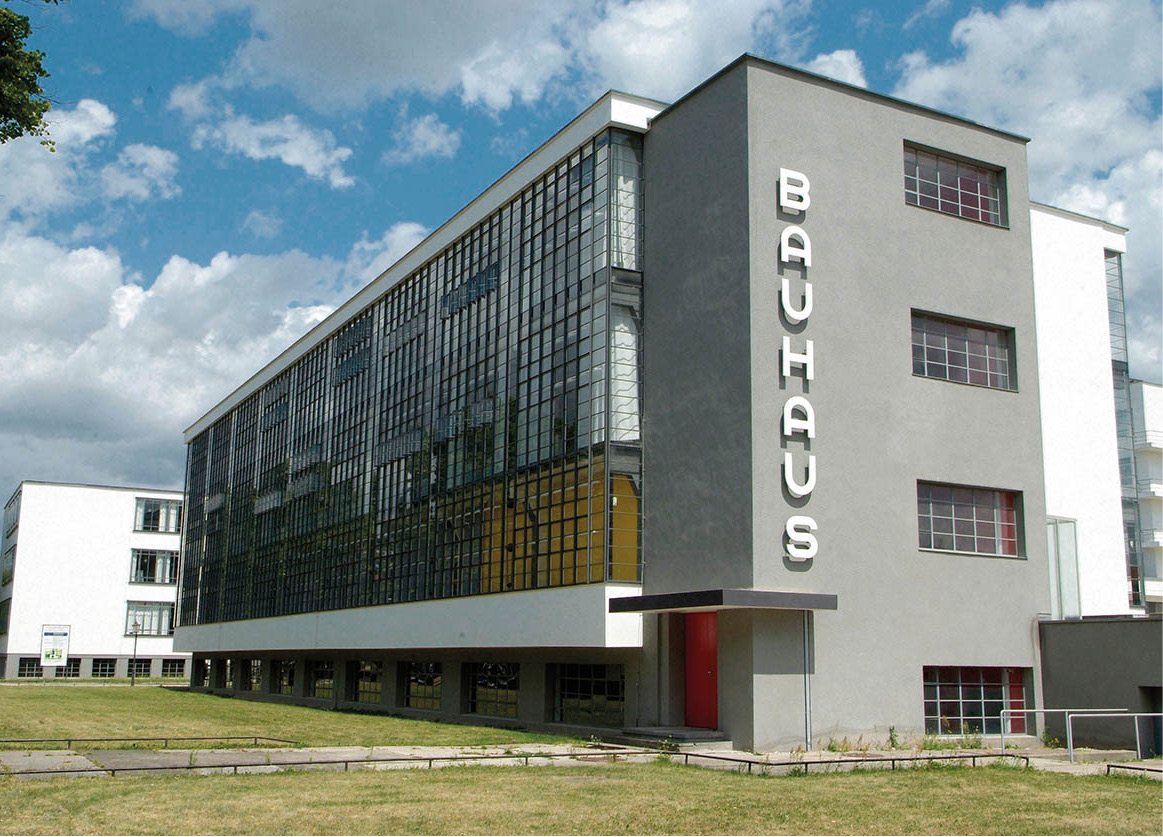
Bauhaus Building in Dessau.
Glyn Genin/Apa Publications
Dessau and Leipzig
Dessau 6 [map], on the main route between Berlin and Leipzig, was home to the ground-breaking Bauhaus School, one of the birthplaces of modern functionalist architecture, from 1925 until it moved to Berlin in 1932. In 1977 the town reopened the Bauhaus-Dessau Building as a museum (daily). It is on the Unesco World Heritage list. There are several other surviving examples of Bauhaus architecture around the town, including the old labour exchange on August-Bel-Platz designed by Walter Gropius, the Bauhaus housing estate with the Cooperative Building in the Törten district, and the Meisterhäuser in Ebertallee.
Dessau’s heyday was the era of Prince Leopold Friedrich Franz von Anhalt-Dessau (1740–1817), who surrounded himself with artists, poets and architects and established a country park at Schloss Wörlitz (Apr–Nov Tue–Sun). Over 800 varieties of trees grow among winding paths, canals and lakes. The art collection includes works by Rubens and Canaletto, while the grounds are dotted with imitation buildings, such as an Italian farmstead, a Greek temple, a Gothic folly and a palm house.
With the founding of its university in 1409, Leipzig 7 [map], already an important trading centre, also became a cultural enclave, subsequently attracting such influential students as Leibnitz, Nietzsche and Goethe, who named Leipzig “Little Paris”. The division of Germany hit the city hard, but today the streets are fast returning to their former elegance. The exquisite interior of the Nikoleikirche (Church of St Nicholas), begun in the 12th century, is testament to the city’s former wealth. The Thomaskirche (Church of St Thomas), home of the Thomanerchor choir, was begun around 1212 and assumed its late Gothic form in the 15th century. The world-famous choir was founded at the same time, at first consisting of only 12 boys who sang at Mass, but soon going on to sing at all major Church and state ceremonies. Celebrating its 800th anniversary in 2012, the choir has maintained its tradition unbroken through the centuries, even under Nazi and Communist rule. Leipzig in the 18th century was above all the city of Johann Sebastian Bach (1685–1750), who became choirmaster and organist at St Thomas’s in 1723 and remained there for the rest of his life, writing his major cantatas for this choir. More can be learnt about his life in the Bach-Museum (Tue–Sun), where the Bach Archive is kept. The Bach Festival is held annually in spring or early summer (www.bach-leipzig.de for dates).

The Zwinger Palace in Dresden.
Glyn Genin/Apa Publications
The palaces of Dresden
Dresden 8 [map] will for ever be associated with the devastating bombing raid of 14 February 1945, when almost the entire city centre was destroyed. A great deal of rebuilding has been done since then, however, to restore the city’s epithet of “most beautiful city in Germany”. A key symbol of the city’s rebirth was the reconsecration in 2005, after 13 years of rebuilding, of the Frauenkirche (Church of Our Lady), a Baroque masterpiece dating from 1743.
Six buildings comprise the Dresden State Art Collections. They include the stunning Dresden Royal Palace, including the Grünes Gewölbe (Green Vault; Wed–Mon), with jewellery, precious stones and paintings belonging to the Saxon princes who built the palace. The Zwinger Palace, a masterpiece of German Baroque (1710–32), was based on the Orangery at Versailles, but the complex of pavilions, galleries and gardens grew to take up a vast area. It contains the Gemäldegalerie Alte Meister (Old Masters’ Gallery; Tue–Sun), holding 2,000 works of art, including the Sistine Madonna by Raphael and Rembrandt’s Self-Portrait with Saskia, plus works by Titian, Ribera and Murillo.
Where
To get a feel for the city of Dresden, take a trip on one of the historic paddle steamers, some dating back to the 1870s, that ply the River Elbe (www.saechsische-dampfschiffahrt.de).
The Albertinum was first built in the 1880s, to house part of the royal art collection. Blown apart in 1945, it was, like much else in royal Dresden, painstakingly rebuilt by the East German regime, but then devastated again by the Elbe floods in 2002. This was taken as an opportunity for comprehensive refurbishment, concluded in 2010. It houses two fine museums (both open Tue–Sun). The Galerie Neuer Meister (New Masters Gallery) has a superb collection of painting from German Romantics like Caspar David Friedrich through the Impressionists and Expressionists to emphatically modern figures like Gerhard Richter; the Skulpturensammlung (Sculpture Collection) has sculpture from the same periods. The Jägerhof (Tue–Sun) houses a fascinating Museum of Saxon Folk Art and a near-unique collection on the history of puppet theatres. Nearby is the former Garrison Church, once the only multi-denominational church in Europe, since it contained a Catholic chapel attached to the main Lutheran church. Finally, in the environs of Dresden is the Schloss Pillnitz (Pillnitz Palace; May–Oct daily), the opulent summer residence of Augustus the Strong (1670–1733). With its sweeping pagoda-like roofs, it is an important example of the Chinoiserie style so fashionable at the time. A large collection of camellias imported from Japan in 1770 provides a riot of blossom in spring. The palace also houses a Museum of Decorative Arts.
The mountain range bordering the Czech Republic southwest of Dresden is the Erzgebirge (Ore Mountains), where minerals such as lead, tin, silver and iron ore have been extracted since the 12th century. The silver-mining town of Freiberg 9 [map] was the richest town in Saxony until the 15th century, and some of the town’s old buildings, such as the 15th-century town hall and cathedral, still display its former wealth.

Thuringian Forest.
Bigstock
Weimar and around
Further west is Weimar ) [map], the natural starting point for any journey across the Thuringian Forest. From the mid-18th century Weimar was one of the great hubs of German cultural life. The poet, playwright, polymath and virtual founder of modern German literature Johann Wolfgang von Goethe (1749–1832) lived here from 1775, when he became privy councillor of the duchy of Saxony-Weimar-Eisenach, and later he served as education minister and director of the Weimar Theatre, where he came into contact with the philosopher, playwright and poet Friedrich Schiller (1759–1805), with whom he shared a close friendship.
The ensemble of 16 historic monuments known as Classical Weimar are now a Unesco World Heritage site. Among them are the Goethe-Nationalmuseum (Tue–Sun) which includes the house where he lived for 50 years, with his 6,500-volume library, and his garden and Gartenhaus (summer house; daily), and also the Schiller-Museum (Tue–Sun), which again includes the writer’s residence. The Stadtschloss (Castle; Tue–Sun) contains a very fine art collection originally amassed by Weimar’s dukes, with paintings by Lucas Cranach the Elder, Tintoretto and Caspar David Friedrich, among others. For more details on all Weimar’s attractions, visit www.klassik-stiftung.de).
West of Weimar, ancient Arnstadt was the home from 1620 of the Bach family. Johann Sebastian Bach was the organist from 1703–7 in the church that today bears his name. To the south, undulating, thickly forested hills, narrow river valleys and rounded mountain tops combine to form the unique quality of the Thuringian Forest. Goethe enjoyed the natural surroundings of this region, and today’s hikers will be in good company if they follow the Rennsteig – a famous 168km (105-mile) ridge path that crosses the area. The route also passes the Grosser Inselsberg (916 metres/3,000ft), only the fourth-highest mountain in the region but the one offering the best views.
Into Bavaria
As you pass beyond the Thuringian Mountains you also cross from the former eastern zone into what was West Germany. This border is fading into history, but at some points marks of the “Green Belt” – where the East Germans cut a swathe through the forest, for security reasons – can still be seen. The town of Bayreuth ! [map] is forever associated with another composer – Richard Wagner, who built an opera house here in 1876. Every year it is the setting for the Bayreuth Festival, from late July to late August, devoted to Wagner’s operas.
Shop
Christmas Markets are a German instititution, and there is one in most towns in the four weeks leading to Christmas. Main squares are taken over by stalls selling handmade Nativity scenes, decorations and a whole variety of traditional foods such as toasted almonds, bratwurst sausage, lebkuchen (special gingerbread) and the indispensable glühwein or mulled wine. Nuremberg, Dresden, Stuttgart, Frankfurt, Dortmund and Trier all have celebrated markets, but some of the prettiest are in Bavarian towns such as Rothensburg and Augsburg.
The city of Nürnberg (Nuremberg) @ [map] was devastated during World War II but has been faithfully restored, so that much of its old charm remains. In the 12th–16th centuries it was regarded as the unofficial capital of the Holy Roman Empire. The River Pegnitz divided the Old City into the Sebalderstadt in the north and the Lorenzerstadt in the south, both surrounded by a sturdy 13th-century defensive wall with 46 fortified towers.
The oldest parts of the enormous Kaiserburg (Imperial Castle; daily), built on sandstone crags high above the Old City, date from the 11th and 12th centuries. Between the 15th and 17th centuries, the city attracted artists and scientists such as Albrecht Dürer, Adam Krafft and Veit Stoss. The Albrecht Dürer Haus (Tue–Sun), near the castle, is now a museum dedicated to the artist who once lived there. The Hauptmarkt (main market) is the site of Nuremberg’s famous annual Christmas Market (Christkindlesmarkt); while at the Kornmarkt the Germanisches Nationalmuseum (Tue–Sun) has a huge collection of artefacts related to German arts and culture, some dating back to prehistory. The city’s biggest museum, though, is the Verkehrsmuseum Nürnberg (Transport Museum) on Lessingstrasse, which houses two separate collections (both Tue–Sun), the DB Museum, the official historical collection of German Railways, and the Museum für Kommunikation (Communications Museum) on postal history.
A darker but still hard-to-escape chapter in Nuremberg’s history was written by the Nazis, who held rallies here between 1933 and 1938.
The Romantic Road to Rothenburg
The Romantische Strasse (Romantic Road), the name given to the route from Würzburg A [map] to Füssen near the Austrian border, leads visitors through many of Bavaria’s greatest attractions. Following massive Allied bombing of Würzburg in March 1945, a painstaking rebuilding programme restored every major structure in the city. Start your tour at the Residenz (daily), built in 1720–44 by Balthasar Neumann as the palace of the prince-bishops who ruled the town. Ranked as one of the finest Baroque palaces in Europe, it is a Unesco World Heritage site. The impressive stairwell is crowned by a single concave vault 30 metres (100ft) long by 18 metres (59ft) wide; even more famous is the ceiling fresco by Giambattista Tiepolo, who was summoned to Würzburg in 1750 to create the largest painting in the world in which he depicted the gods of Olympus and allegories of the four continents known at the time. Leave time to stroll in the Hofgarten behind the Residenz, with its fine wrought-iron gates and beautiful Baroque figures.

Würzburg, a must-see in Bavaria.
iStockphoto
From the Residenz follow Hofstrasse to Kiliansplatz and the Romanesque cathedral, rebuilt after its destruction in 1945. The Schönborn Chapel, one of Balthasar Neumann’s most important works, contains a shrine to the prince-bishops from the Schönborn family. Cross the River Main by the Alte Mainbrücke (Old Main Bridge) and follow the steep path up to the Festung Marienberg (Marienburg Fortress; mid-Mar–Oct Tue–Sun). Begun in the 13th century, the massive rectangular fortress encloses a courtyard and 13th-century keep as well as the Renaissance fountain and the Church of St Mary. After 1631, when the city was taken by Gustavus Adolphus of Sweden during the Thirty Years War, the fortress was extended and began to take the form seen today, with its Baroque facades and the Fürstengarten (Princes’ Garden).
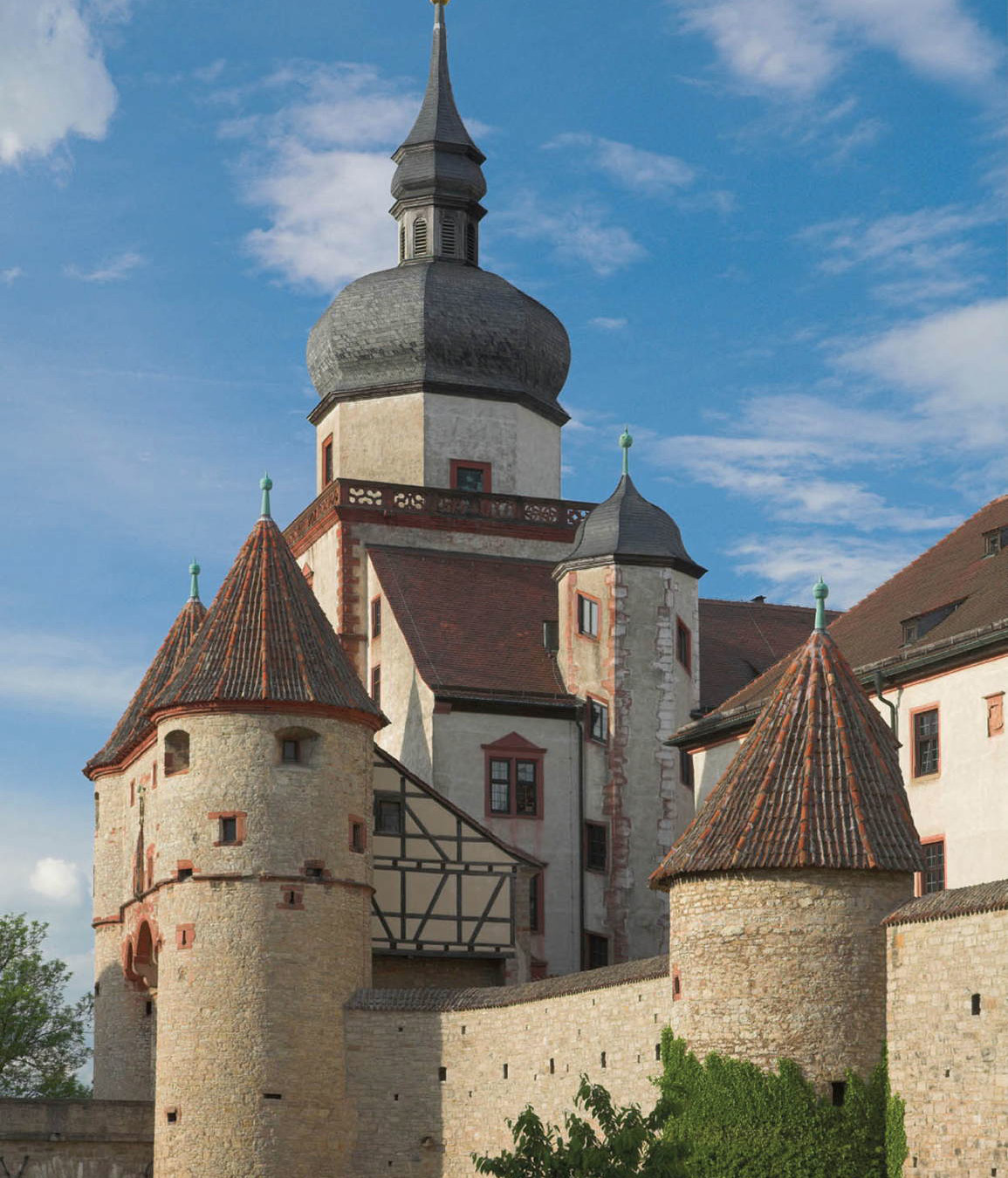
Marienberg Fortress, Würzburg.
iStockphoto
One of the main attractions of the fortress is the Mainfränkisches Museum (Main-Franconia Museum; Tue–Sun), whose exhibits include a remarkable collection of statuary by the woodcarver and sculptor Tilman Riemenschneider (1460–1531), who came to Würzburg from the Harz Mountains in 1483.
Tip
Take a steamer along the Main to Veitshöchheim (7km/4 miles), where you can visit the Baroque palace with its beautiful Rococo gardens, once the summer residence of the Würzburg bishops. The steamers leave Würzburg at the landing stage located close to the Alter Kranen.
The Romantic Road continues through Tauberbischofsheim B [map] (Home of the Bishop), where St Boniface founded a convent in 725, and Lauda-Königshofen C [map], which for centuries has been a wine-producing centre. Riemenschneider’s greatest achievement can be admired in Creglingen D [map] at the Herrgottskirche (Church of Our Lord), where his carved altarpiece is dedicated to the Virgin.
One of the best-preserved medieval towns in Germany is Rothenburg ob der Tauber E [map], whose special status from 1274 as a free imperial city provided the basis for its prosperity. Its streets converge like the spokes of a wheel from the city walls to the central market place and the Rathaus (town hall) with a Renaissance archway and Baroque arcades. Its 55-metre (180ft) Gothic tower affords the best view of the town’s maze of red-tiled roofs. The medieval churches are rich in ecclesiastical art, the pride of the town being the Heilig-Blut Altar (Altar of the Holy Blood) in the St-Jakobs-Kirche (Church of St James), commissioned from Riemenschneider in 1501–5. The Plönlein area in the centre is the prettiest part of Rothenburg.

Medieval Rothenburg.
Glyn Genin/Apa Publications
Continuing south to Neuschwanstein
The Romanesque cloisters of the Stiftskirche (Collegiate Church) in Feuchtwangen F [map] serve as a stage for excellent open-air theatre in summer. Dinkelsbühl G [map], a little further south, can only be entered through one of its four main gates. Here, each July, the Kinderzeche play and a colourful parade commemorate the time in the Thirty Years War when the town was besieged by the Swedes. From the tower of St George’s Church in Nördlingen H [map] there is a panoramic view of the 99 villages of the Rieskrater, a crater formed 15 million years ago when a meteorite struck the earth’s surface at a speed of around 70,000km (40,000 miles) per hour, creating a wall-like formation of rock and earth about 13km (8 miles) in diameter. The modern Rieskratermuseum (Tue–Sun) has a multimedia show explaining the geological history. Continue on through Harburg I [map], with one of Germany’s oldest castles, and Donauwörth J [map], home of the Käthe Kruse dolls, made here since 1910. The Käthe-Kruse Puppen-Museum (Doll Museum; Apr–Oct Tue–Sun pm, Nov–Mar Wed, Sat–Sun pm) is worth a detour for doll-lovers.
The medieval trading city of Augsburg K [map] grew into a commercial centre, noted for its goldsmiths and silversmiths, and an episcopal seat at the crossroads of the important routes linking Italy and the centre of Habsburg power in the Holy Roman Empire. By about 1500 it was among the largest cities in the German-speaking world. The immensely wealthy Fugger banking family, bankers to the Emperor Charles V, was responsible for the extraordinary social housing settlement of the Fuggerei (1516), where poor Catholic senior citizens could live for a peppercorn rent; the same applies today.
The town has a wealth of artistic treasures, including the Renaissance Rathaus (City Hall), with onion-domed towers and magnificent Goldener Saal (Golden Hall; daily). The Romanesque-Gothic Cathedral (Dom) is the home of precious works of art, including the oldest stained-glass windows in Germany, dating from around 1130.

Neuschwanstein Castle belongs in a fairy tale.
iStockphoto
Neuschwanstein Castle (daily) near Füssen L [map] was built by the “Mad King” of Bavaria, Ludwig II in 1869–86 as a realisation of his Wagnerian romantic fantasies, and was a total anachronism even then. Its sole raison d’être was as a glorified stage set. In the Sängersaal, the “Minstrels’ Hall” that forms the centrepiece of the fairy-tale castle, Ludwig staged performances of scenes from Tannhäuser and other Wagner operas.
Regensburg to Munich
The 2,000-year-old city of Regensburg £ [map], at the northernmost point of the River Danube, was largely undamaged during World War II. There is a fine view from the Steinerne Brücke (Stone Bridge), a masterpiece of medieval engineering some 310 metres (1,017ft) in length. The river is lined by stately mansions, over whose roofs tower the Gothic spires of St Peter’s Cathedral. To the north, the landscape of the dense Bavarian Forest extends as far as the Czech border, and is a great place to get away from it all.
Duke Heinrich der Löwe (Henry the Lion) of Bavaria performed a historic function 800 years ago when he put a new bridge across the River Isar to transport salt from the mines in Bad Reichenhall to Augsburg. Munich $ [map] (München), the town that grew up around the bridge, took its name from the occupants of a nearby monastery and was originally called Mönchen (Little Monk). Its symbol is still a childlike monk, the Münchner Kindl (Munich Child). It was not until the 19th century that the city, in the reigns of Ludwig I and Ludwig II, acquired a reputation as a centre for the arts and sciences, due to these monarch’s hugely ambitious and flamboyant architectural projects.
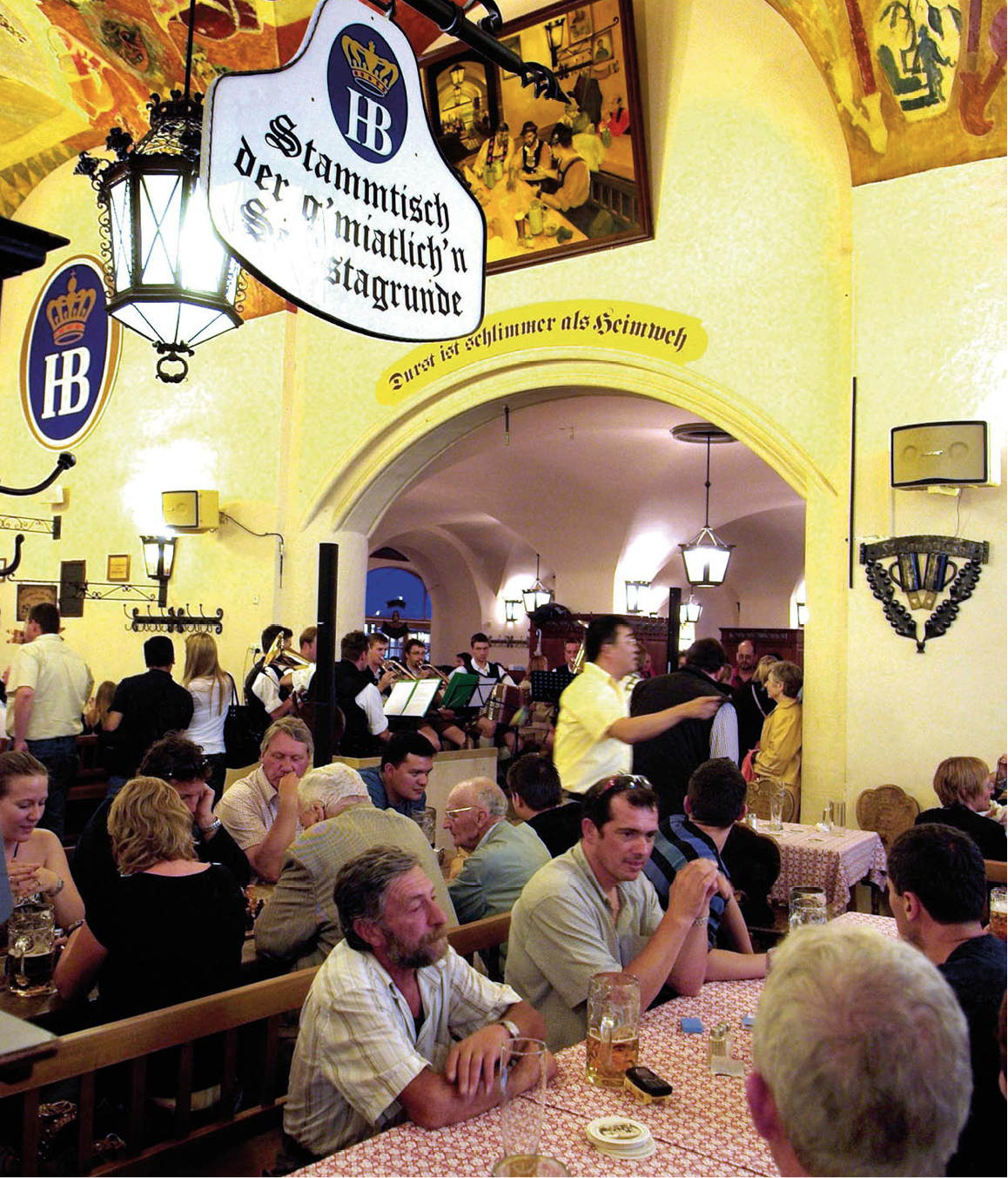
The Hofbräuhaus in Munich.
Glyn Genin/Apa Publications
Munich’s true centre begins near the Hauptbahnhof (main railway station) at busy Karlsplatz. Through the imposing gate, the 14th-century Karlstor, you reach a pedestrian zone, passing the Renaissance Michaelskirche (St Michael’s Church) where Ludwig II is buried. The Frauenkirche (Church of Our Lady), one of the largest hall churches in southern Germany, is a late Gothic edifice of red brick, with two distinctive onion-domed towers. Central Marienplatz throbs with life throughout the year. In winter the Christmas Market takes over, the stalls clustering around the statue of Munich’s patron, the Virgin Mary. One side of the square is taken up by the Neo-Gothic Neues Rathaus or New Town Hall (1867–1908), with a world-famous Glockenspiel in its tower. The mechanical figures perform three times a day in summer (11am, noon and 5pm) and at 11am and noon in winter. South of the square is bustling Viktualienmarkt, where you can buy sausages, herbs, fruit, wines and home-brewed beer. Most visitors find their way (east of the Rathaus) to the famous Hofbräuhaus, the former beer halls of the court brewery, for true Bavarian atmosphere, beer and food.
The historic rooms of the Residenz (Royal Palace; daily) are worth a tour. They include the Antiquarium, an impressive Renaissance hall now used for state receptions, the ornate Schatzkammer (Treasury) and the Rococo Cuvilliés Theatre, which is still in use. To the east, beyond the Isartor, another of the old city gates, lies the Deutsches-Museum (daily), focusing on science and technology.
The Königsplatz, northwest of the centre, is perhaps the most impressive square in Munich, built on a huge scale in monumental Neoclassical style. Here you will find the Antikensammlung (Museum of Classical Art; Tue–Sun), with renowned Greek vases and Roman and Etruscan statues, and the Glyptothek (Tue–Sun), devoted to Greek and Roman sculpture. The square is also the hub of Munich’s Kunstareal or “Art District”. Not far away, the Alte Pinakothek (Old Picture Gallery; Tue–Sun) houses one of the greatest of all collections of art by European Old Masters from the 14th to the 18th centuries, originally drawn from the Bavarian royal collection. Its many masterpieces include Dürer’s astonishing 1500 Self-Portrait and major works by Raphael, Rembrandt, Poussin and Rubens. The adjacent Neue Pinakothek (New Picture Gallery; Wed–Mon) has mainly 19th-century art, with standout paintings by Monet and Van Gogh. Nearby there is now a third museum, the Pinakothek der Modern (Gallery of the Modern; Tue–Sun), a stunningly sleek building housing four separate collections covering contemporary art, graphic art, design and architecture.
The city in love with beer
By five o’clock on a hot summer’s afternoon, you can find most of Munich’s population sitting out under the chestnut trees in one of the city’s beer gardens, hoisting a mass (a litre mug) of beer, polishing off a hendl (roast chicken) and lingering into the night, when lights in the trees light up the area like a stage set.
Class barriers are unknown here. At the same table, a group of rowdy teens may be seated between middle-aged men in tracht (national costume) and elegantly coiffed ladies. Self-service is the rule, and standing in line is part of the experience. Not that you have to buy all your food: many families come with picnic baskets and even checked tablecloths, just picking up beer to complete the meal.
The summit of Munich’s beer culture, and its biggest beer garden, is of course Oktoberfest, the 16–18-day festival of drinking and eating – which actually begins in late September – that each year attracts millions, including hordes of young Antipodeans and North Americans, to the huge permanent site of Theresienwiese on the west side of the city. Oktoberfest statistics are staggering: each year 7 million litres (12.3 million pints)) of beer, half a million chickens and 70,000 pigs’ knuckles are consumed, and there are plenty of entertainments too, in scores of tents and fairground rides, with Bavarian oom-pah music as accompaniment.
Oktoberfest and Nymphenberg
The open space of Theresienwiese, just west of the centre, is the site of the world-famous 14-day Oktoberfest, which has been held in the city since 1810 and draws more than 6 million visitors every year. The ultra-modern headquarters and museum of the BMW motor company (Tue–Sun), shaped like a car cylinder, lie to the north of the ring road around the city.
Also outside the city centre is Schloss Nymphenburg (daily), the huge and opulent summer residence of the Bavarian princes and kings, amid a gorgeous park with both French-style and English-style gardens and the Amalienburg hunting lodge, a masterpiece of Rococo decoration. The palace’s central pavilion, completed in 1675, has spectacular ceiling frescoes by Johann Baptist Zimmermann. The southern pavilion contains the famous Schönheitsgalerie (Gallery of Beauty), with paintings of women commissioned for the delectation of King Ludwig I, including his mistress the dancer Lola Montez, as well as, in the former stables, samples of the work of the former royal Nymphenburg porcelain factory.

The BMW Museum in Munich.
Glyn Genin/Apa Publications
Stuttgart and the Black Forest
West of Bavaria, in the historic territory of Württemberg, the whole length of road from the ancient university town of Freiburg to Stuttgart winds along narrow river valleys of outstanding natural beauty. Tourists have been coming to the Schwarzwald (Black Forest) since the 18th century, attracted by the contrast between the Rhine Plain and the mountains rising some 1,200 metres (4,000ft) above it. There are lovely quiet roads for drivers to explore, and the forested slopes above the picture-postcard valleys are great for walking. Grouse and pheasant, buzzards and hawks, deer, foxes and badgers populate more remote areas. Among the many famous beauty spots are Germany’s most celebrated waterfalls at Triberg, the Feldberg, the Black Forest’s highest peak, which towers above Freiburg, the lakes of Schluchsee and Titisee in the southern forest and medieval Calw and its surrounding villages near Stuttgart.
Stuttgart % [map], surrounded by forested hills and speckled with parks, has one of the highest per capita incomes of any city in Germany, due in part to its manufacture of Mercedes cars. Opulence was displayed differently by the rich and powerful in earlier times, as evidenced by the striking central ensemble of the 16th-century Altes Schloss (Old Palace; Tue–Sun) and 18th-century Neues Schloss (New Palace; open only for specially arranged tours) on Schillerplatz. Well worth a visit outside the city centre are the Daimler-Benz Museum (Tue–Sun) in the district of Untertürkheim, and the Porsche Museum (open Tue–Sun) in Stuttgart-Zuffenhausen.

A view of Heidelberg from the castle.
Glyn Genin/Apa Publications
Down the Neckar valley to Heidelberg
Although the spa tradition of Baden-Baden goes back to Roman times, it was not revived until 1838, when Jacques Bénazet opened his luxurious Casino in the Kurhaus, making the town newly fashionable among the wealthy of Europe. The existence of Karlsruhe ^ [map], further north, is entirely due to Schloss Karlsruhe, the palace that Margrave Karl Wilhelm of Baden-Durlach built around 1715. Most of its attractions are found around the palace, which houses the Badisches Landesmuseum (Baden State Museum; Tue–Sun), with a varied display on the region’s history and arts. Nearby are the Staatliche Kunsthalle (State Art Gallery; Tue–Sun), a large collection particularly strong on German Old Masters, the Impressionists and contemporary art, and the lovely Botanischer Garten (Botanical Garden; Tue–Sun). The Museum beim Markt (Museum in the Market Square; Tue–Sun), in the town centre, is an attractive small museum of 20th-century decorative arts, and the Museum in der Majolika (Tue–Sun) displays one of Karlsruhe’s traditional products, majolica pottery.
Fact
Heidelberg’s castle complex, with its fortifications, domestic quarters and palaces, took 400 years to complete, so the building styles evolved all the way from 14th-century Gothic to Baroque.
Heidelberg & [map] lies on the edge of the Odenwald Forest, where the Neckar reaches the Rhine Plain, and is regarded as the epitome of German Romanticism. High above the picturesque lanes, the ruins of the castle (daily; guided tours) rise majestically. To the left of the massive gate tower, the simple Gothic House is the oldest part of the complex. In the cellar is the famous Heidelberg Tun, one of the largest wine vats in the world. The most interesting part of the castle is the Otto-Heinrich Wing, which houses the Deutsches Apothekenmuseum (German Apothecary Museum; daily), a collection of furniture, books, medical instruments and medicine bottles. Beneath the castle, the six arches of the Alte Brücke (Old Bridge) span the river. Its 13th-century gate is topped by Baroque spires and leads to Philosophenweg or “Philosopher’s Way”, a hillside promenade around the Heiligenberg (Holy mountain). In the Old City, near the Kornmarkt, you will find two of Heidelberg’s most famous student taverns, and the mighty, late Gothic Heiliggeistkirche (Church of the Holy Ghost).
Frankfurt
Germany’s financial centre is Frankfurt * [map] on the River Main, which has developed into a pulsating metropolis thanks to its location at the intersection of road, rail and air traffic routes. The skyscrapers housing international banks and financial corporations create a dramatic skyline that epitomises the power of this bustling city.
Reflected in the glass of soaring modern buildings is the Gothic tower of Frankfurt’s cathedral, and apple-wine pubs stand at cobblestone-street level in Sachsenhausen. An impressive collection is on show at the Museum für Moderne Kunst (Museum of Modern Art; Tue–Sun); and nine museums line the south bank of the Main, in a district known as the Museumsufer. The Städel Museum (Tue–Sun) displays paintings from the 14th century to the present, while the Liebighaus (Tue–Sun) exhibits sculptures from antiquity to the Baroque period. The Deutsches Filmmuseum (Tue–Sun) documents the German film industry, and also screens films. Others include the Deutsches Architekturmuseum (German Architecture Museum; Tue–Sun), the Museum für Angewandte Kunst (Museum of Applied Arts; Tue–Sun) and the Museum der Weltkulturen (Ethnological Museum; Tue–Sun).
In the city centre, the Römer or town hall (daily) is a collection of three Neo-Gothic buildings and includes the church where the Holy Roman Emperors were crowned. The nearby Goethehaus (Grosser Hirschgraben 23–25; daily) is the house where Goethe, Germany’s greatest man of letters, was born in 1749.
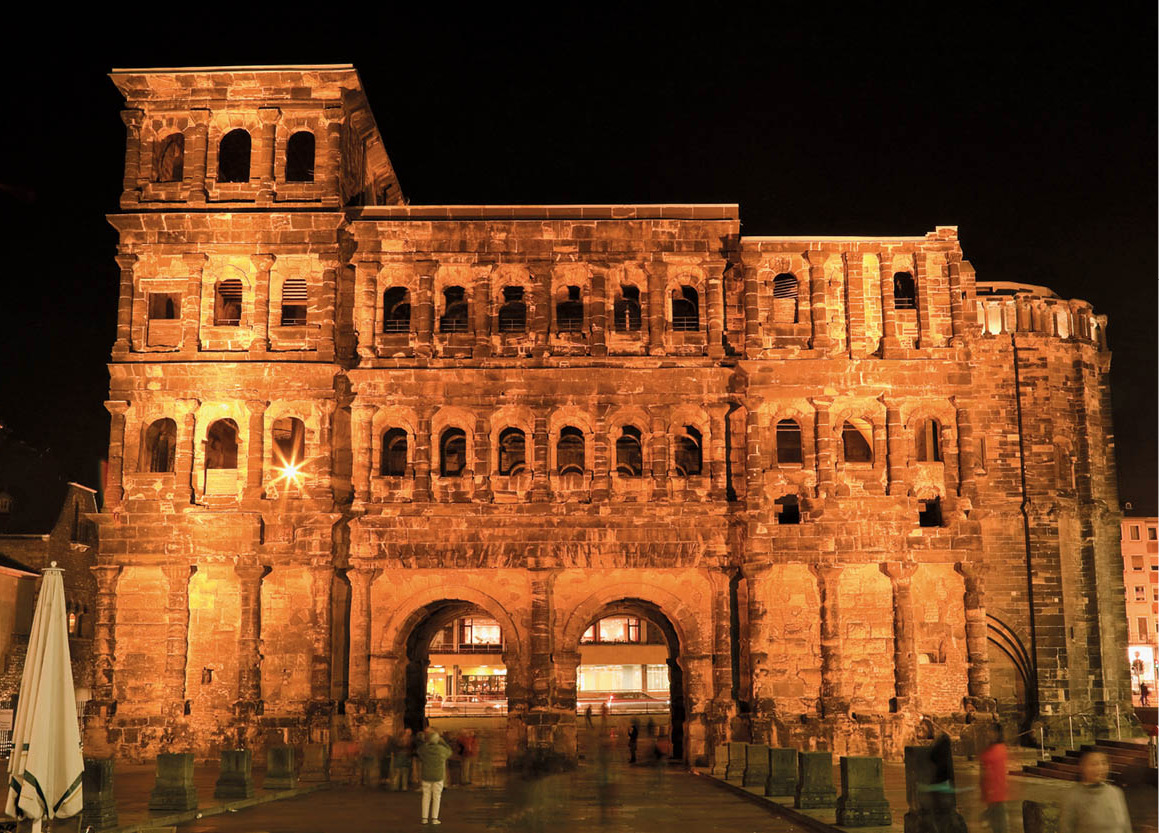
The colossal Roman Porta Nigra in Trier.
iStockphoto
The Rhine and Moselle
The Main slices through Frankfurt on its way to join the Rhine. Not far from their confluence lies the ancient city of Mainz ( [map], founded in 38 BC. In AD 747 St Boniface made it the seat of an archbishopric, and the centre of Germanic Christendom. Johannes Gutenberg (c.1397–1468), the inventor of printing, is Mainz’s most famous son. Two of his 42-page Latin Bibles can be seen in the Gutenberg-Museum (Tue–Sun), along with old printing apparatus and a replica of the master’s workshop.
Where
The idyllic Moselle Valley is the best known of Germany’s wine-producing areas. Winningen, Zell, Bernkastel-Kues and Piesport are typically picturesque towns and villages along the river’s route.
Almost due west, in the heart of the Moselle Valley, is Trier ‚ [map], the oldest city in Germany, founded in 16 BC by the Roman Emperor Augustus. Dominated by the well-preserved Porta Nigra, the huge Roman gate, the city is a treasure chest of ruins and relics, and many residents dabble in archaeology. It is said that, to store potatoes safe from the winter frost, the people simply dig down to the Roman mosaics. The Rheinisches Landesmuseum (Rhineland Museum; Tue–Sun) has a wealth of Roman treasures, including mosaics, sculpture, glass and coins. The fortress-like, Romanesque Trierer Dom (St Peter’s Cathedral) is one of Germany’s oldest churches.
Tip
Cruises down the Rhine to see the beauties of the river were among Europe’s first regular tourist excursions in the 19th century, and are just as popular today. Many routes are available, including the complete cruise from Zurich into Holland, but the most famous section is the Rhine Gorge either side of Koblenz, with beauty spots celebrated in German folklore such as the Lorelei Rock, home of the Rhine maidens. One-day river trips operate from Mainz and Koblenz; see www.kdrhine.com.
At Koblenz ⁄ [map], the Mosel (or Moselle), perhaps Germany’s loveliest river, joins the Rhine. Where the two great rivers meet stands an impressive monument known as the Deutsches Eck (German Corner). On the opposite side of the river, high on the edge of a ridge, stands Ehrenbreitstein (daily; guided tours), a 13th-century fortress that once controlled this key area and changed hands several times between the French and Germans. Above the Pfaffendorfer Brücke (Pfaffendorf Bridge), with the Moselle on the left and the Rhine on the right, is the famous Wine Village, built in 1925 as a replica of a wine-producing village, complete with authentic vineyards and typical half-timbered houses from the most celebrated German wine-growing regions.

Cyclists on the bridge near Cologne’s cathedral.
Glyn Genin/Apa Publications
Germany’s industrial heartland
With the fall of the Berlin Wall, the city of Bonn ¤ [map] gave the role of German capital back to Berlin. Before it was chosen as the seat of the Federal Government in 1949, the major claim to fame of this sleepy city was as the birthplace of Ludwig van Beethoven (1770–1827). But, thanks to its Museum Mile, Bonn still has a lot to offer, including the Kunst und Ausstellungshalle (Art and Exhibition Hall), the Kunstmuseum (Museum of Art) and the Alexander Koenig Museum (Zoological Museum; all museums open Tue–Sun). Exhibits at the Beethoven-Haus (Tue–Sun) include the piano made specially for the composer in Vienna.
Where
Cologne’s carnival is one of the biggest traditional festivals in Europe, and still raucously observed. Officially, carnival season actually begins in November, so some partying goes on through the winter, but its real heart is the week up to Ash Wednesday, with its peak on “Rose Monday”, when there are massive parades, with giant floats satirising politicians and other faces in the news, and half or more of the city comes out in fancy dress.
Köln ‹ [map] (Cologne) is a lively city, famous for its twin-spired cathedral (dom) and exuberant carnival celebrations and religious processions. The spirit of Cologne is embodied in its mighty cathedral and the Severinsbrücke (Severin Bridge) named after a 4th-century bishop of Cologne, a unique construction crossing the Rhine, supported by only one off-centre pillar. The cathedral contains what are said to be the remains of the Wise Men of the East, the paintings of Stephan Lochner (c.1445) and a feeling of immense space that has an awesome effect on the visitor. Begun in 1248, its twin spires, each 157 metres (515ft) high, were not built until 1842–80.
The city also has some excellent museums. The Römisch-Germanisches Museum (Romano-Germanic Museum; Tue–Sun) contains priceless treasures and offers an insight into the city’s Roman past. It was built around the world-famous Dionysus Mosaic, which was discovered during construction work on an air-raid shelter. The 2nd-century masterpiece covers an area of 70 sq metres (84 sq yds) and consists of more than 1 million ceramic and glass components. Next door is a museum complex that includes the Museum-Ludwig (Tue–Sun), with gleaming white spaces that house a fabulous collection of contemporary art and superb temporary exhibits. Cologne’s most unmissable museum, though, may be the Schokolade Museum (Chocolate Museum; Tue–Sun), beside the river near the Severinsbrücke, which comprises a comprehensive display on everything to do with chocolate, with of course plenty of tasting opportunities in the café.
If you have time, take a detour to Aachen, one of Germany’s oldest cities and the favourite residence of Charlemagne, who is buried in the Cathedral there, before visiting Düsseldorf › [map], 40km (25 miles) north of Köln. Düsseldorf’s trademarks, the Schlossturm (Castle Tower) and the Lambertuskirche (Church of St Lambert), with its characteristic slightly crooked spire, stand directly by the Rhine. Take a stroll along the Uferpromenade, the pedestrianised space between the river and the bustling Old Town – a square mile packed with pubs and restaurants. The Kunstsammlung Nordrhein-Westfalen (State Art Collection; Tue–Sun) on Grabbeplatz has 20th-century works by artists ranging from Picasso to Lichtenstein, and a comprehensive collection of works by Klee.
The towns to the north in the Ruhr district – Duisburg, Essen – have been the industrial heartland of Germany since the mid-19th century. Nowadays many of its old installations are no longer productive and are being turned into tourist attractions, notably the vast Zollverein mining complex in Essen, with imposing Bauhaus architecture, which is open for tours (daily), and houses a visitor information centre for the whole Ruhr area. Dortmund fi [map], on the eastern edge of the Ruhr, is at the top of the German brewing league. Indeed, more brewing goes on here than in any other city in Europe, including its rival to the south, Munich. All is explained in the Brauerei-Museum (Brewery Museum; Tue–Sun).
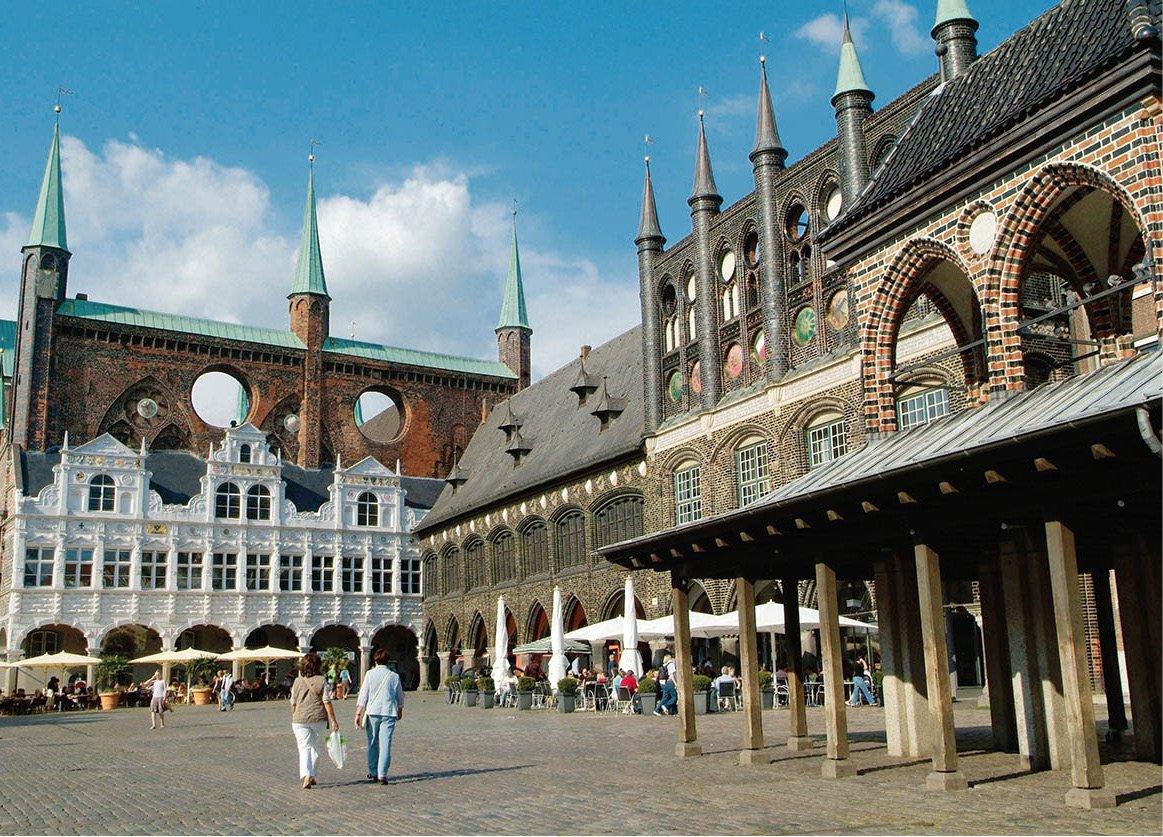
Lübeck’s town hall and marketplace.
Glyn Genin/Apa Publications
On the trail of the Brothers Grimm
Further east, the picturesque Weser Valley picks up the trail of the Märchenstrasse or “Fairy-Tale Road”, which leads from Hanau, birthplace of Jacob and Wilhelm Grimm, to Bremen. Riverside meadows, spruced-up towns, castle ruins and Renaissance palaces make it seem as if time has stood still here. In Hameln fl [map] (Hamelin), the Rattenfängerhaus recalls the story of “The Pied Piper of Hamelin”, and every Sunday in summer a play depicting the legend is performed in front of the Hochzeitshaus (Wedding House), dating from 1617.
The old Hanseatic town of Bremen ‡ [map] is the oldest German maritime city, although its modern deep-sea port of Bremerhaven, 57km (35 miles) further north, was founded in the 19th century. “The Bremen Town Musicians”, a dog, a donkey, a cat and a cockerel, from the story by the Brothers Grimm, stand near the Rathaus (town hall). The cavernous cellar beneath this building is famous for its Gothic vaults. In Bremerhaven, the Zoo am Meer (daily) is a striking modern zoo making the most of its coastal location that particularly focuses on aquatic birds and animals, which can be observed through huge glass screens.
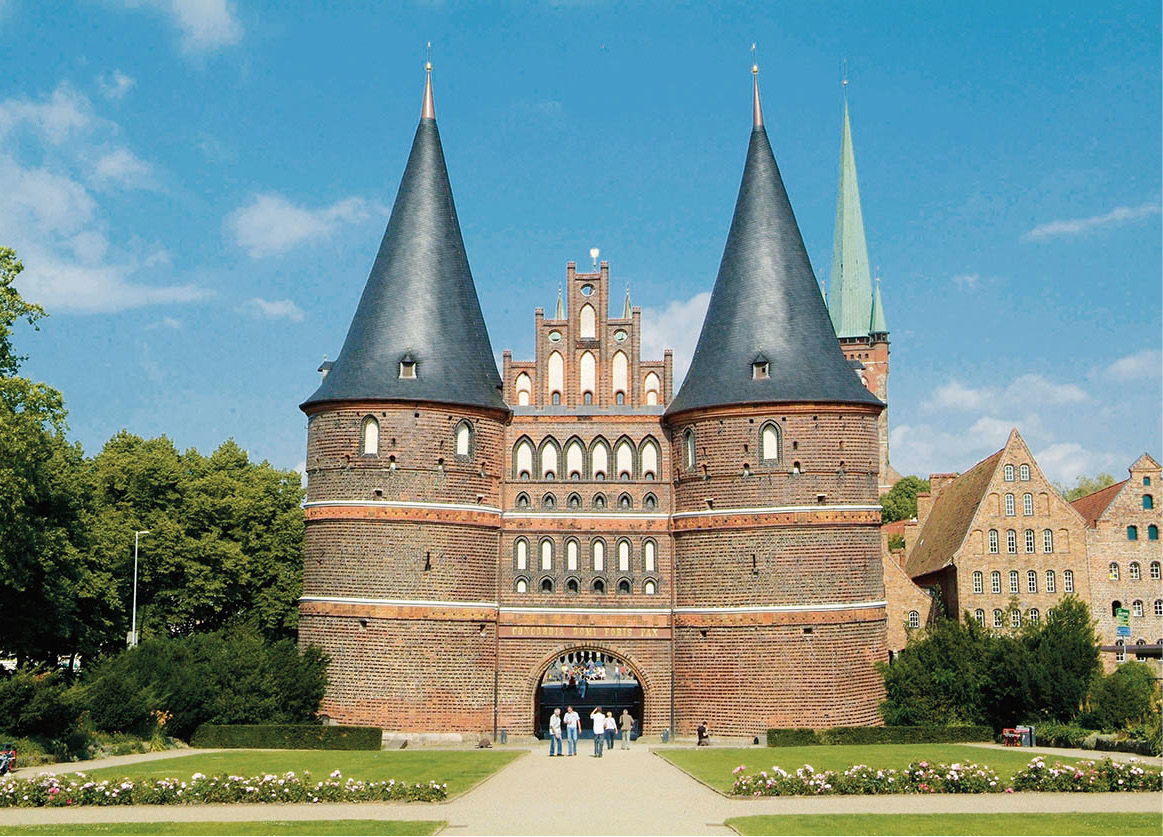
Lübeck’s Holsten Gate.
Glyn Genin/Apa Publications
Maritime Hamburg
Hamburg ° [map] is Germany’s second-largest city (population 1.8 million), and a major port, although it is 110km (66 miles) from the sea. Ships reach it by sailing up the River Elbe, and one of the most attractive areas is the Speicherstadt, the old warehouse district, which can be explored on a narrow-boat cruise.
Hamburg’s red-light district, the Reeperbahn, may be one of Europe’s raunchiest, but the area is well policed. A more salubrious side of town can be seen by strolling from the railway station into the centre. To the north of the station is the Kunsthalle (Art Gallery; Tue–Sun), with paintings and sculpture from the 13th–20th centuries. On the other side of the station is one of the world’s best Jugendstil (Art Nouveau) collections, in the Museum für Kunst und Gewerbe (Arts and Crafts Museum; Tue–Sun). Surprisingly, Hamburg’s most popular visitor attraction is Miniatur Wunderland (daily), a vast model-railway complex in an old harbour warehouse.
Lübeck · [map], on the Baltic Sea, was a commercial metropolis of the Holy Roman Empire for 250 years, and by 1356 was the most powerful of the Hanseatic towns that controlled Baltic trade. It is now a prime port for ferries to Scandinavia. The Holstentor (Holsten Gate), one of the few remaining sections of the city wall, leads to the Old Town, and Lübeck’s five Gothic brick churches with their combined Seven Towers, a trademark image of the city. Travemünde in Lübeck Bay has been Lübeck’s beach outlet since the 19th century. Since unification, other Baltic coast towns lying further east such as Heiligendamm near Rostock or Stralsund have regained their traditional status as some of Germany’s most popular summer beach resorts, attracting crowds from all over the country.
